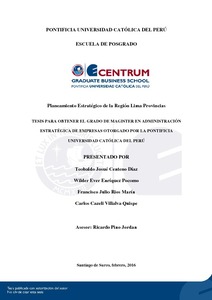| dc.contributor.advisor | Pino Jordán, Ricardo Miguel | |
| dc.contributor.author | Centeno Díaz, Teobaldo Josué | es_ES |
| dc.contributor.author | Enríquez Pocomo, Wilder Ever | es_ES |
| dc.contributor.author | Rios Marín, Francisco Julio | es_ES |
| dc.contributor.author | Villalva Quispe, Carlos Cazeli | es_ES |
| dc.date.accessioned | 2017-04-12T22:41:22Z | |
| dc.date.available | 2017-04-12T22:41:22Z | |
| dc.date.created | 2016 | |
| dc.date.issued | 2017-04-12 | |
| dc.identifier.uri | http://hdl.handle.net/20.500.12404/8435 | |
| dc.description.abstract | La presente tesis desarrolla el Plan Estratégico de la Región Lima Provincias, región
con un gran potencial por explotar que podría convertirse en eje de desarrollo de la zona
centro occidental peruana, los grandes recursos naturales con los que cuenta, su cercanía a la
Ciudad de Lima y los Tratados de Libre Comercio (TLC) suscritos por el Perú con otras
naciones son grandes oportunidades para insertarla en la economía nacional y mundial.
La metodología empleada para la formulación del presente plan estratégico se basa en
el Modelo Secuencial del Proceso Estratégico desarrollado por el profesor D’Alessio. Para el
desarrollo del presente plan estratégico, se revisó información bibliográfica disponible sobre
la región basada en fuentes confiables, a partir de esta información se pudo conocer la
situación actual en la que se encuentra la región, luego se realizó un análisis tanto externo
como interno, lo cual permitió formular estrategias que permitirán aprovechar las fortalezas y
oportunidades y minimizar las amenazas y debilidades de la región, permitiendo de este
modo alcanzar la visión deseada: Para el 2025, la Región Lima Provincias será una de las
tres regiones más competitivas del país: desarrollando su potencial exportador, agropecuario,
minero y turístico; invirtiendo en infraestructura, educación, salud y saneamiento básico;
optimizando el uso adecuado de sus recursos naturales; mejorando la calidad de vida de sus
habitantes y respetando el medio ambiente. El logro de la visión se basa en el cumplimiento
tanto de objetivos a corto y largo plazos. El Tablero de Control Balanceado (Balanced
Scorecard -BSC) permite controlar el cumplimiento y medir el resultado de cada objetivo a
corto plazo. Cumpliendo el presente plan estratégico, se avisora un buen futuro para la
Región Lima Provincias | es_ES |
| dc.description.abstract | This thesis develops the Strategic Plan of Lima Provincias Region, a region with a
huge untapped potential that may become a development axis of Midwestern Peru, its
proximity to Lima City and the Free Trade Agreements (FTA) signed by Peru with other
nations are great opportunities to insert this region into national and global economy.
The methodology used for the formulation of this strategic plan is based on the
Strategic Sequential Process Mode, which was developed by Professor D'Alessio. For
developing this strategic plan, available bibliographic information was reviewed and was
based on reliable sources about the region, this information helped us to learn about the
current situation of the region, after that, both external and internal analysis was made, it
allowed us to formulate strategies that will leverage the strengths and opportunities and
minimize the threats and weaknesses of the region, allowing this way to achieve the desired
vision: By 2025 Lima Provincias Region will be one of the three most competitive regions of
the country: by developing its export, agriculture, mining, and tourism potential; by investing
in infrastructure, education, health, and basic sanitation; by optimizing the proper use of
natural resources; by improving the quality of life of its inhabitants, and by respecting the
environment. By achieving the vision is based on compliance with both short- and long-term
goals. The Balanced Scorecard (BSC) allows us to control compliance, and measure the
outcome of each short-term goal. Fulfilling this strategic plan envisions a better future for
Lima Provincias Region | es_ES |
| dc.language.iso | spa | es_ES |
| dc.publisher | Pontificia Universidad Católica del Perú | es_ES |
| dc.rights | Atribución-NoComercial-SinDerivadas 2.5 Perú | * |
| dc.rights | info:eu-repo/semantics/openAccess | es_ES |
| dc.rights.uri | http://creativecommons.org/licenses/by-nc-nd/2.5/pe/ | * |
| dc.subject | Planificación regional -- Perú -- Lima | es_ES |
| dc.subject | Desarrollo regional -- Perú -- Lima | es_ES |
| dc.subject | Planificación estratégica | es_ES |
| dc.title | Planeamiento estratégico de la Región Lima Provincias | es_ES |
| dc.type | info:eu-repo/semantics/masterThesis | es_ES |
| thesis.degree.name | Magíster en Administración Estratégica de Empresas | es_ES |
| thesis.degree.level | Maestría | es_ES |
| thesis.degree.grantor | Pontificia Universidad Católica del Perú. CENTRUM | es_ES |
| thesis.degree.discipline | Administración Estratégica de Empresas | es_ES |
| renati.discipline | 413307 | es_ES |
| renati.level | https://purl.org/pe-repo/renati/level#maestro | es_ES |
| renati.type | https://purl.org/pe-repo/renati/type#tesis | es_ES |
| dc.publisher.country | PE | es_ES |
| dc.subject.ocde | https://purl.org/pe-repo/ocde/ford#5.02.04 | es_ES |






